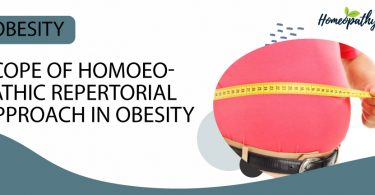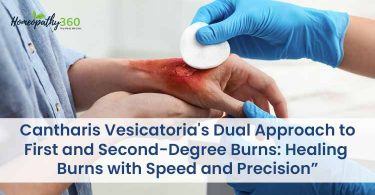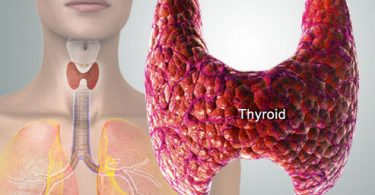
Abstract
Background: Thyroid disorders are very common, affecting 750 million people worldwide by recent World Health Organization (WHO) estimates, being possibly even more prevalent than diabetes. The drug of choice is thyroxine which the patient has to take throughout their life, this leads the patient to look for an alternative therapy. With the increasing reliance on alternative treatments there is need to formulate methods for the fast and reliable prescriptions. Homoeopathy has emerged as the trustworthy line of treatment in many of the chronic diseases. Many researches both clinical and preclinical have shown the plausibility of the evidence-based medicine.
Materials and Methodology: A known case of HYPOTHYROIDISM presented with the menstrual irregularities and hairfall.The pre and post thyroid profile were taken as the evidence for the case, other than that the zulewski’s score pre and the post scores were taken to assess the symptomatic relief .
Conclusion: With the individualization of the case, Sulphur was considered as the indicated remedy and was seen quite effective in the treatment of hypothyroidism in the patient.
Keywords: Hypothyroidism, homoeopathic intervention, Sulphur.
Abbreviations:( WHO )world health organization,(LMP) last menstrual period, (TDS) thrice a day. (EMES) every morning empty stomach, (TSH) thyroid stimulating hormone, (T4) tetraiodothyroning, (T3) triiodothyronine.
Introduction
Thyroid diseases are amongst the commonest endocrine disorders around the world including India. According to a projection from various studies on thyroid disease, it has been estimated that about 42 million people in India suffer from thyroid diseases. 1
Thyroid diseases are different from other diseases in terms of their ease of diagnosis,
accessibility of medical treatment, and the relative visibility that even a small swelling of the thyroid offers to the treating physician. Early diagnosis and treatment remains the cornerstone of management. Hypothyroidism is caused by inadequate function of the gland itself (primary hypothyroidism) or by not enough stimulation by thyroid-stimulating hormone (central hypothyroidism).2Primary hypothyroidism is more common than central hypothyroidism.
3.It can cause number of constitutional symptoms, such as increase weight, dry skin,
menstrual irregularities, falling of hairs, cold intolerance, constipation, hoarseness of
voice, coldness of skin, and generalised debility and fatigue. In children,hypothyroidism leads to delays in development, which is called cretinism in severe cases. The classical signs and symptoms of various grades of hypothyroidism can be estimated with clinical scores named as zulewski’s score4,this questionnaire helps in clinically monitoring the case.The outcome assessment is based on the criteria that lower the score the better the results.
Homoeopathy has proved its effectiveness in various clinical conditions including endrocrinological disorders. As homoeopathy, like other sciences, is attaining the plausibility as an evidence-based science, this case report will be adding on to the evidence basis to the science.
MATERIALS AND METHODS
Case profile
Presenting complaints
A 27 years old unmarried female presented the complaint of absence of menses since last 3 months, and falling of hair from scalp,
History of present complaints
Patient has been preparing for competitive examination in a coaching centre from last 4 years. There were two to three episodes of grief after declaration of results. She had increasing body weight from last 2 years. With a continuous 4-6 hours of study in coaching and 6-8 hours at home, patient stay in a sedentary life style. She has irregular menstrual cycle from last 3-4 years. Hair falling from scalp from last 1 year.
Past history
Irregular menstrual cycle from last 3-4 years. Mostly treated with hormone therapy but after 3-4 cycles again absence of menses. In 2012, diagnosed with hypothyroidism and took thyroxin 25 mg up to 3 months.
Family history
Father-diabetic, mother- hypothyroidism.
Gynaecological & Obstetrical History
Gynaecological history:
- Menarche: at 12 years
- LMP: 19/01/16
- Menstruation:
- Duration: 3 days
- Cycle(interval): 32-35 days
Treatment history
Hormone therapy
Physical generals:
Patients is sensitive to heat with complaints of amenorrhoea,falling of hairs,aversion of milk,hoarseness of voice,dryness of skin,constipation ,disturbed sleep.
Mental generals:
Irritable and become angry to trifle things.
Life space investigations:
Patient was born in a middle class hindu family. She was the 3rd of the three
children to her parents. Father had diabetes, mother had hypothyroidism. Patient was worried about her future.
Physical examination
Patient was found to be obese.
Systemic examination
On musculoskeletal examination, it was noted that there was hard bony overgrowth at forearm, thighs, knees,legs and ankles. There was no tenderness while examining the bones.No signs of inflammation seen.
Respiratory system: vesicular breathing with no added sounds.
Nervous system: ankle reflex took slightly more time.
Laboratory investigations
| Previous investigations | Investigations advised |
| 23.06.2012 | 26.04.2016 |
| T3- 96 ng/dl T4- 6.9 mg/dl TSH- 17.2uIU/ml | T3 T4 TSH |
Provisional diagnosis:
Hypothyroidism: the well-known signs and symptoms of hypothyroidism are dry skin, cold sensitivity, fatigue, muscle cramps, voicechanges, and constipation that results from an intrinsic disorder of the thyroid gland (primary hypothyroidism). In this situation, serum T4 is low and TSH is elevated, usually in excess of 20 mU/L.5
Miasmatic diagnosis6
Scanty menstruation, hoarseness of voice, constipation, dryness of skin , hair falling from scalp
Psoric in nature
| Symptoms | Intensity | Common/uncommon | Miasm6 |
| Mental generals | |||
| Anger | ++ | Uncommon | Psora |
| Irritability | ++ | Uncommon | Psora |
| Physical generals | |||
| Aversion to milk | ++ | Uncommon | Psora |
| Desires sweets | ++ | Uncommon | Psora,Syphillis |
| Amenorrhoea | ++ | Common | Psora |
| Disturbed sleep | ++ | Common | |
| Obesity | ++ | Common | Psora |
| Constipation | ++ | Common | Psora |
| Particulars | |||
| Coarse skin | + | Common | – |
| Hoarseness of voice | ++ | Common | Psora |
| Dryness of skin | ++ | Common | Psora |
| Falling of hair from scalp | + | Common | Psora,Syphillis |
Table :Analysis and evaluation of the case
Totality of symptoms
- Anger
- Irritability
- Menses absent
- Aversion milk
- Desire sweets
- Skin dry
- Obesity
- Hair falling from scalp
- Hoarseness of voice
- Constipation
Selection of medicine
Repertorial method-Synthesis 10.0 Repertory7 has been used for repertorisation
Rubrics selection
Table 01:Repertorial totality with rubrics
| Symptoms | Rubrics |
| Anger | MIND- anger |
| Irritability | MIND- irritability |
| Aversion to milk | APPETITE- Aversion- milk |
| Desire to sweets | APPETITE- Desire- sweets |
| Menses absent | FEMALE GENITAL/SEX-MENSES- absent |
| Dryness of skin | SKIN AND EXTERIOR BODY- Dry |
| Obesity | SENSATION AND COMPLAINTS IN GENERAL – obesity |
| Hair falling from scalp | HEAD- External- hair – falling out |
| Constipation | STOOL- constipation |
| Hoarseness of voice | VOICE AND SPEECH- Hoarse |
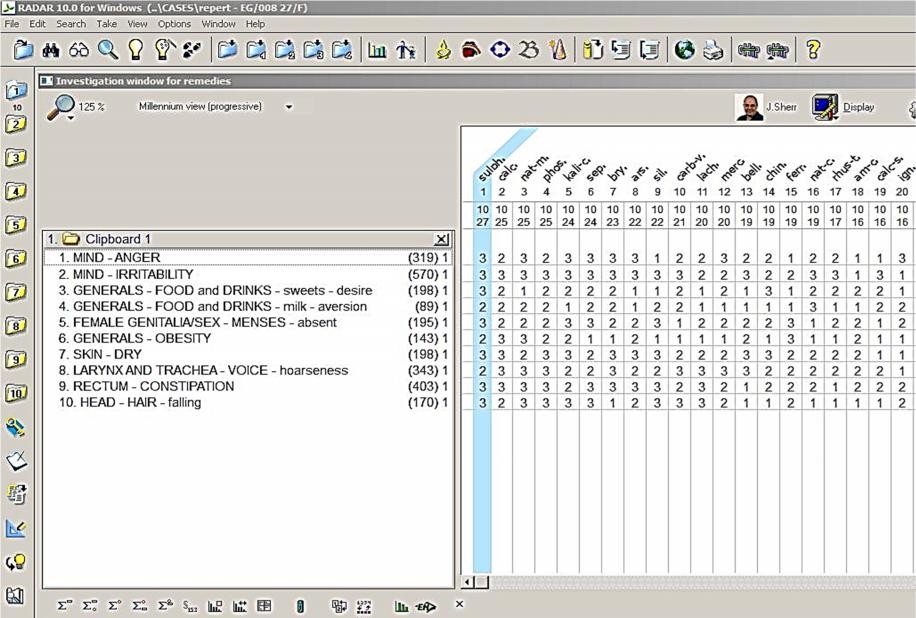
Fig 01:Repertorial chart 7.
Top 5 suggested medicines on repertorisation
Sulphur- 10/27
Calcarea carb[Y1] onicum- 10/25 Natrummuriaticum10/25 Phosphorus – 10/25
Kalim carbonicum- 10/24
, Sulphur covered the totality of symptoms quantitativelyas the remedy for this patient[Y2] . Selection of remedies was based on the repertorisation of totality of symptoms.
- The constitutional remedy was selected after repertorial analysis in consultation with Materia Medica,8,9,10,11.. Though Calcarea carbonicum, Natrium muriaticum, Phosphorus and Kalium carbonicum were close in qualitative totality.Sulphur was ahead of them, corresponding to the patient with thermal reaction which is Hot patient.
First Prescription:
1. Sulphur. 200/ 1 Doses EMES + PL 30 / TDS x 14 days(every morning empty stomach)200 C potency was prescribed based on the susceptibility of the patient 12.13
General management According to a special health report by harvard medical college about the healthy eating for healthy thyroid 14
Patient was advised to-
- Liquid and fibre rich food, diet including green vegetables and fruits intake should be more.
- Avoid foods such as fatty, carbohydrate rich and sweet.
- Avoid goiterogenic food like cabbage, cauliflower and broccoli.
- Regular morning brisk walk along with yoga and meditation.
Zulewski’s score:
Interpretation: Hypothyroidism- hypothyroidism- intermediate hypothyroidism
| Units | Base line value 26.04.2016 | 1st follow up 26.07.2016 | 2nd follow up 25.10.2016 |
| T3 ng/dl | 132 | 134 | 130 |
| T4 ug/dl | 8.8 | 8.9 | 9.2 |
| TSH uIU/ml | 13.8 | 14.2 | 3.8 |
FOLLOW-UP
| Date | Sign and symptoms | Prescription |
| 26.04.2016 | Amenorrhea since 3 months | |
| Falling of hairs from scalp | Sulphur 200 / 1 Dose EMES | |
| Anger & irritability marked | ||
| Aversion to milk | PL 30/TDS X 14 DAYS | |
| Hoarseness in voice | ||
| Scanty perspiration | ||
| Dry & coarse skin | ||
| Constipation | ||
| Continue increasing body weight | ||
| Serum TSH- 13.8 uIU/ml, Zulewski’s Score- 7 | ||
| 10.05.2016 | All the sign & symptoms are same except | PL 30/TDS X 14 DAYS |
| mild improvement in constipation, | ||
| 24.05.2016 | All the sign & symptoms are same | |
| except moderate improvement in constipation, | PL 30/TDS X 14 DAYS | |
| 07.06.2016 | ||
| Menstrual cycle started on 02.06.2016 | ||
| Marked improvement in constipation , | PL 30/TDS X 28 DAYS | |
| weight increase slight slow, mild improvement | ||
| in falling of hairs & in irritability, all other sign | ||
| & symptoms are SQ, | ||
| 05.07.2016 | ||
| Menses does not appear at regular time, | ||
| mild improvement in falling of hairs, | PL 30/TDS X 14 DAYS | |
| all other sign & symptoms are SQ, | ||
| 19.07.2016 | Menses does not appear at regular time, | PL 30/TDS X 7 DAYS |
| Moderate improvement in falling of hairs, | ||
| all other sign & symptoms are SQ, | ||
| Menses does not appear at regular time, | ||
| 26.07.2016 | Moderate improvement in Falling of hairs | |
| from scalp, speed of weight increase slightly | Sulphur 200 / 1 Dose EMES | |
| slow, moderate change observed in irritability, | ||
| all other sign & symptoms were in SQ | PL 30/TDS X 14 DAYS | |
| Serum TSH- 14.2 uIU/ml, Zulewski’s Score- 6 |
| Date | Sign and symptoms | Prescription |
| 09.08.2016 | LMP-30.07.2016 | PL 30/TDS X 28 DAYS |
| Menstrual flow remains for 2 days, | ||
| Moderate improvement in Falling of hairs from | ||
| scalp, speed of weight increase slightly slow, | ||
| moderate change observed in irritability, mild | ||
| improvement in hoarseness of voice & dryness of | ||
| skin, all other sign & symptoms were in SQ | ||
| 06.09.2016 | Menses does not appear at regular time, Marked improvement in Falling of hairs from scalp | PL 30/TDS X 14 DAYS |
| and in irritability, speed of weight increase slightly | ||
| slow, moderate improvement in hoarseness of | ||
| voice& dryness of skin, all other sign & symptoms were in | ||
| Status quo | ||
| 20.09.2016 | PL 30/TDS X 28 DAYS | |
| LMP-09.09.2016 | ||
| Menstrual flow for 2 days, | ||
| Marked improvement in Falling of hairs from | ||
| scalp, hoarseness of voice, dryness of skin & in | ||
| irritability, speed of weight increase slightly slow, | ||
| all other sign & symptoms were in Status quoQ | ||
| 18.10.2016 | ||
| LMP-17.10.2016 | PL 30/TDS X 7 DAYS | |
| Menstrual flow for 2 days, | ||
| 25.10.2016 | Sulphur 1M / 1 Dose EMES | |
| In general, patient improved. According to i. | Symptoms came to status quo so the potency have been raised based on susceptibility. | |
| zulewski’s scoring (7 to 4), ii. Serum TSH Level | ||
| (13.8 to 3.8), but still patient having | PL 30/TDS X 28 DAYS | |
| irregularities in menstrual cycle, increase in | ||
| weight, diminished sweating. | ||
| Patient on treatment continued. |
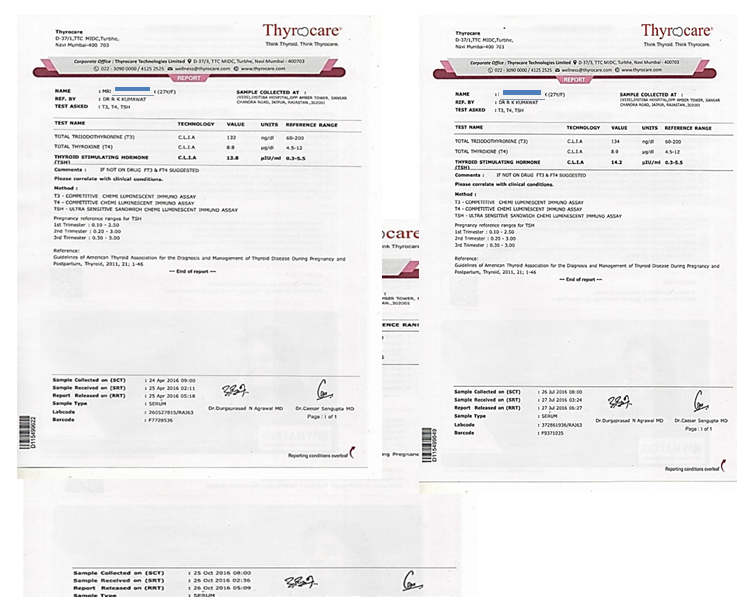
| Baseline-26.04.2016 | TSH level 13.8 uIU/ml Zulewski’s Score- 07 |
| 26.07.2016 | TSH level 14.2 uIU/ml Zulewski’s Score- 06 |
| 25.10.2016 | TSH level 3.8 uIU/ml Zulewski’s Score- 04 |
DISCUSSION
As evident from this case, Sulphur showed improvement in the evidences as evident in the thyroid profile and the zulewski’s score.
Calcarea carbonica, Graphites, Lachesis, Lycopodium, Natrum muriaticum,
Pulsatilla, Sepia officinalis, and Sulphur are few of the frequently prescribed constitutional
homeopathic remedies for hypothyroidism. Many stalwarts have mentioned in their Materia medica ,8,9,10,11,,and Repertory books 15,16,17about the action of Sulphur ,According to Materia medicas Sulphur covers most of symptoms like anger and irritability,hairfall,hoarseness in voice,dryness of skin,aversion to milk ,desires sweets,constipation,Amenorrhoea .
In the Synthesis Repertory16 and Kent17Repertory under the rubric- EXTERNAL THROAT – PAIN – stitching – Thyroid Gland; EXTERNAL THROAT – SWELLING – Thyroid gland–;mentions Sulphur as a remedy.
CONCLUSION
This case is one of the evidence-based documented research studies, that shows effectiveness of homoeopathic treatment not only in relieving the symptoms of hypothyroidism, but also in bringing favourable changes in pathology as evident in the investigations. Thus, this study is the classical example of the holistic approach of homoeopathy.
REFERENCES
- Nagarkar R., Roy S., Mohammad A., Palwe V., Kulkarni N., Pandit P. Incidence of
Thyroid Disorders in India: An Institutional Retrospective Analysis DOI:10.5958/2394 4196.2015.00012.6
- Garber JR; Cobin RH; Gharib H; Hennessey JV; Klein, I; Mechanick JI; et al.
2012.”Clinical Practice Guidelines for Hypothyroidism in Adults” (PDF).Thyroid 22(12):1200, 1235.doi:10.1089/thy.2012.0205. PMID 22954017.accessed on 2015 July 3
- Persani L . “Clinical review: Central hypothyroidism: pathogenic, diagnostic, and
therapeutic challenges”. The Journal of Clinical endocrinology and Metabolism
(Review) 97 (9):3068–78.doi:10.1210/jc.20121616. PMID 22851492.
- Zulewski H, Muller B, Exer P, Miserez AR, Staub JJ. Estimation of tissue hypothyroidism by a new clinical score: Evaluation of patients with various grades of
hypothyroidism and controls. J Clin Endocrinol Metab 1997;82:771-6.
- Sawin CT, Castelli WP, Hershman JM, McNamara P, Bacharach P. The aging thyroid. Thyroid deficiency in the Framingham Study. Arch Intern Med.1985;145:1386-1388.
- Patel P R.Chronic miasm in homoeopath and their cure with classification of their rubrics in Dr Kent’s Repertory.New Delhi;Indian books and periodical publishers:1996.
- Schroyens F. Radar10. Belgium: Archibel Homoeopathic Software; 2009.
- Allen TF. Encyclopedia of pure Materia Medica. New Delhi: B. Jain Publishers Pvt.Ltd;1995.
- .Hering C. Guiding Symptoms of Our Materia Medica. vol 2. New Delhi: B Jain Publishers Pvt Ltd ; 1995.
- Farrington E A.Lectures On Clinical Materia Medica. Edition.New Delhi:Bjain Publishers Pvt Ltd;1999
- Clarke JH. A Dictionary of Practical Materia Medica. New Delhi: B. Jain Publishers Pvt.Ltd.;1995
- Kent JT. Lectures of Homoeopathic Philosophies. New Delhi: B. Jain Publishers
Pvt. Ltd;1989.
- Dudgeon R E.Lectures on the theory and practice of homoeopathy.New Delhi.B.Jain Publishers Pvt Ltd.2003
- Healthy eating for healthy thyroid.Harvard health available from.https//:www.health.harvard.edu accessed on 2020 feb 12
- Boericke W.Boericke’s New manual of homoeopathic materia medica with repertory. Third revised & augmented edition based on 9th ed. India: B.Jain publishers; 2015
- Schroyens F. Repertorium Homeopathicum Syntheticum;Ed. 9.1; London; Homeopathic Book Publishers;2004.
- Kent JT. Repertory of the Homoeopathic Materia Medica. 6th American ed. New Delhi.B.Jain Publishers(P) Ltd. 2012.
[Y1] Write complete names of all remedies in italics
[Y2] Cite the reference from authentic source
[Y3] Explain this questionnaire with cited reference in the above article (under introduction)


